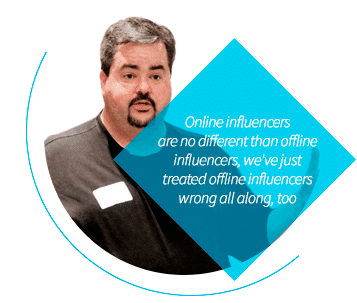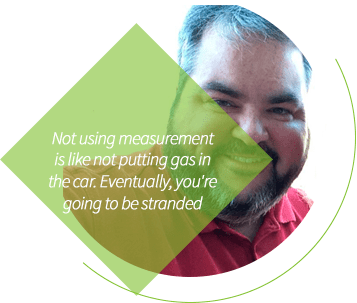He was a creator of the Social Media Explorer — one of the most relevant blogs about social media. Jason Fall’s business is one of the top US-based agencies offering digital marketing and public relations consulting services to brands. In his Twitter bio you’ll find the description: “Husband, Father, Author, Speaker, Humorist. Allegedly wise to the ways of PR, Digital Marketing and Social Media. I like bourbon.” And even that is not enough to talk about all he does.
He was also one of our prized interviewees on the 2014 Digital Communication Map that we published last week, along with Joe Pulizzi, Jay Baer and others. Today we are posting his full interview — Don’t miss anything because Jason provides an insightful review on all that’s changing in communication and PR environments.
So, get a pen and paper or an iPad for the tech savvy: you’ll definitely take away some pointers from Jason Falls' interview!
In this article you’ll learn…
How has the work of communication professionals evolved over the past 5 years?
The work of communication professionals has evolved more in the last five years than probably any similar period before. With the explosion of social networks like Facebook and Twitter, not to mention to the genetic link to public relations from them, to the rise of mobile marketing and the necessity to communicate in short spurts rather than larger format media plans, the role of a communicator today is vastly different than 2009. The media landscape is infinitely fractured, content marketing is bombarding consumers from every angle — creating a lot of noise and not a lot of signal — and even the device most people consume media on is different. It’s smaller and always with them. Those are some pretty big changes and the need for a communications professional to operate all the time, read and react to far more “media” outlets (empowered consumers who are always on) and be as much technologists as communicators is imperative.
We were talking about traditional PR some years ago. Now, do you think it’s online content that’s responsible for most corporate communication?
In my view public relations (PR) has simply evolved to be focused on the digital world first. Outside of paid social advertising, all the facets of social marketing have offline relation to aspects of public relations. Whether it’s media relations (blogger and influencer outreach), community relations (community management), collateral (content marketing) or other aspects of PR, they all have some application in the world of social media. PR is still the initiation point for communications. It’s just more modern, more technology driven and nimble.
Influencer Marketing: What do new online influencers (bloggers, twitter users…) tend to expect from companies?
Many may disagree with me, but I’ve always said that online influencers are no different than offline influencers, we’ve just treated offline influencers wrong all along, too. All an influencer wants is for the public relations professional to respect their time, know their needs and audience and keep their communications with them relevant. Sending every press release you have to any influencer is a waste. I’dguess one out of every 15 press releases most companies send is actually of any interest or use to the media professional, blogger or influencer. If PR professionals did a better job of working a list of highly relevant influencers and got to know them so well they could cater each pitch to ensure the right message is getting in front of the right audience at the right time and in the right location (the influencer/blogger’s site in question), then relevance will rule the day and you’ll be successful. Additionally, if an influencer has a paid model (online advertising, sponsored content, etc.), the PR professional should know that and leverage it when appropriate. Trust them to maintain trust in their audience. Don’t shun them because someone once told you that sponsored content was less trustworthy.
And what is an influencer able to offer to a company? (What is their intrinsic value?)
It depends. If an influencer can drive his or her audience to take action, they’re priceless. Some will. Some won’t drive any action at all. Others will drive a little, but passively. Find the ones who have the “how high” response from their audience when they say, “Jump!” That’s where you want to focus.
Are press releases really dying? What should a press release have to actually deliver value to an influencer?
Press releases are dying because they’re useless. What an influencer typically wants or needs is the facts. Media advisories with the list of who, what, when, where, why and how are more useful for the influencer, in most cases. Unless they have a sponsored content element, they don’t typically want you to create content for them — that’s what they’re good at. Give them the information and resources to tell your story for you.
What kinds of press releases should companies publish?
The only press release a company should ever issue is to media outlets that are foolish enough to copy-paste it into their content.
Social networks: can we do public relations through them?

Certainly you can. By communicating on social networks, brands have a golden opportunity to create awareness, build relationships, earn trust and even potentially drive returns. Public relations professionals have always found communities to leverage to get the word out about a product or service — Rotary Club, Chamber of Commerce Meetings, trade publications and their readers. Online is no different. If you can find a pocket of interested parties on Facebook, LinkedIn, Twitter and others, then find them, participate in their conversations and after time, you’ll earn the trust to be able to proactively call on them to buy, vote, think, etc., whatever and however you wish.
Is it important to measure the return on investment (ROI) of our communication actions? If so, why?
It’s important to measure everything, especially communication. Without measuring, you not only don’t know if you’ve met or surpassed your goals for a communications project, but you have no idea what to do differently to make it bigger, faster, better the next time around. Not using measurement is like not putting gas in the car. Eventually, you’re going to be stranded.
Have you got any advice for communication professionals?
It would do communications professionals well to understand data and its implications on communications efforts and fast. The next few years will center around finding relevant audiences and communicating in relevant ways. By knowing not just someone’s demographics or cookie data from their browser, but also knowing a person’s interests and seeing their social graph (their friends) and all the data that brings with it, you can better refine your targeting, segmentation and messaging to be more efficient with your efforts. Without leveraging and understanding data and how to use it, manipulate it and more, you’re going to struggle.
Could you give us a forecast about what is going to happen in the communication arena in 2015?
The two themes that will dominate communication in the next year will be relevance and mobile. Relevance, I touched on already. We have to use as much data as possible to segment and target to our audiences as surgically as possible. The more relevant the communication, the more efficient the overall communications become. You’ll get more for your money. And we’ve now reached the tipping point where more people are reading emails on phones and tablets than on desktop computers. The mobile revolution is upon us and businesses not already leveraging mobile techniques are behind the curve. Even Google has thrown down the mobile gauntlet, verifying that if a website does not have mobile optimization, it can be devalued in the search algorithm on mobile devices. If you don’t have mobile in your plans, you can count less visitors and fans in your metrics.
Jason Falls is SVP of Digital Strategy for Elasticity, an innovative digital marketing firm with offices in St. Louis, Mo., and Louisville, Ky. He is the author of two books on digital marketing, founder of popular industry blog SocialMediaExplorer.com and a frequent analyst and commentator on the social media and digital marketing landscape.
Visit his website to know more: JasonFalls.com
